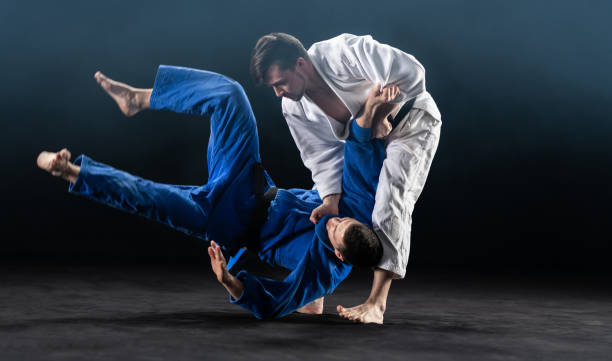What Is Judo

The History of Judo
The history of judo starts with Japanese ju-jitsu. Japanese ju-jitsu was practiced and continually improved upon by the Samurai. They utilized the throws and joint locks common within the art as a means to defend against attackers with armor and weapons.
But in mid-19th century activities like martial arts and ju-jitsu declined. In fact, during this time many ju-jitsu schools disappeared and some martial ideas and practices were lost.
This led the world to judo. Judo is primarily a throwing style of martial arts. One of the main characteristics that set it apart is the practice of using an adversary’s force against them. By definition, Kano’s art stresses defense.
Though strikes are sometimes a part of their forms, such maneuvers are not used in sport judo or randori (sparring). The standing phase when throws are employed is called tachi-waza. The ground phase of judo, where opponents are immobilized and the use of submission holds may be employed, is called ne-waza.
The basic goal of a judoka is to take an opponent down by using their energy against them. From there, a judo practitioner will either gain a superior position on the ground or subdue an aggressor by employing a submission hold.
Dr. Jigori Kano: The Inventor of Judo
Jigori Kano was born in Japan in 1860. As a child, Kano was small which led to his study of ju-jitsu at the age of 18.
While training, Kano started to formulate his own opinions regarding martial arts. This eventually led him to develop a martial arts style all his own. In principle, this style sought to utilize an opponent’s energy against them and eliminated some of the ju-jitsu techniques he deemed dangerous. By doing the latter, he hoped that the fighting style he was refining would eventually gain acceptance as a sport.
At the age of 22, Kano’s art came to be known as Kodokan Judo. His ideas were perfect for the times he lived in. By changing martial arts in Japan so that they could be sports and teamwork friendly, society accepted judo.
Kano’s school, called the Kodokan, was established in Tokyo. In 1886, a contest was held in order to determine which superior, ju-jitsu was or judo, Kano’s students of judo won this competition easily.
In 1910 judo became a recognized sport; in 1911 it was adopted as a part of Japan’s educational system; and in 1964 in Tokyo it became an Olympic sport for Men, and subsequently 1992 in Barcelona for women.
British Judo
With the intention of establishing a ju-jitsu school in England, Mr E W Barton Wright sponsored a visit in 1899 of a team of Japanese judo experts. Best known among them was Yukio Tani, who remained in England after his compatriots had returned home and in 1920 was formally appointed chief instructor to a new club for “the study of systems developed by the samurai” The Budokwai. Neither he nor the club’s founder Gunji Koizumi could have foreseen that they were creating an institution soon to become the most famous judo school outside Japan.
Tuition was given in judo, and other aspects of Japanese culture; Tani continued as instructor until retirement in 1937. Gunji Koizumi was to European judo what Kano was to world judo. He first came to Britain in 1906 and returned to open the Budokwai as a cultural centre and social club for the Japanese community in London. The official opening took place on 26 January 1918 and within 4 months the membership had grown to 44 including 2 Englishmen.
The Budokwai educated several generations of judo men at a time when genuine judo clubs were few and far between. For many years it was the only authoritative source of Kodokan judo in Europe. The link had been forged by Jigoro Kano during an extended visit to Britain in 1920
Koizumi’s vision for the growth of judo on an international basis began to materialize in 1948. On 24 July that year the British Judo Association (BJA) was established as the representative national body; four days later a meeting approved the constitution of a European Judo Union (EJU) to represent judo in the continent of Europe. Three years later the International Judo Federation (IJF) was created as an inter-continental body with overall control of judo.
